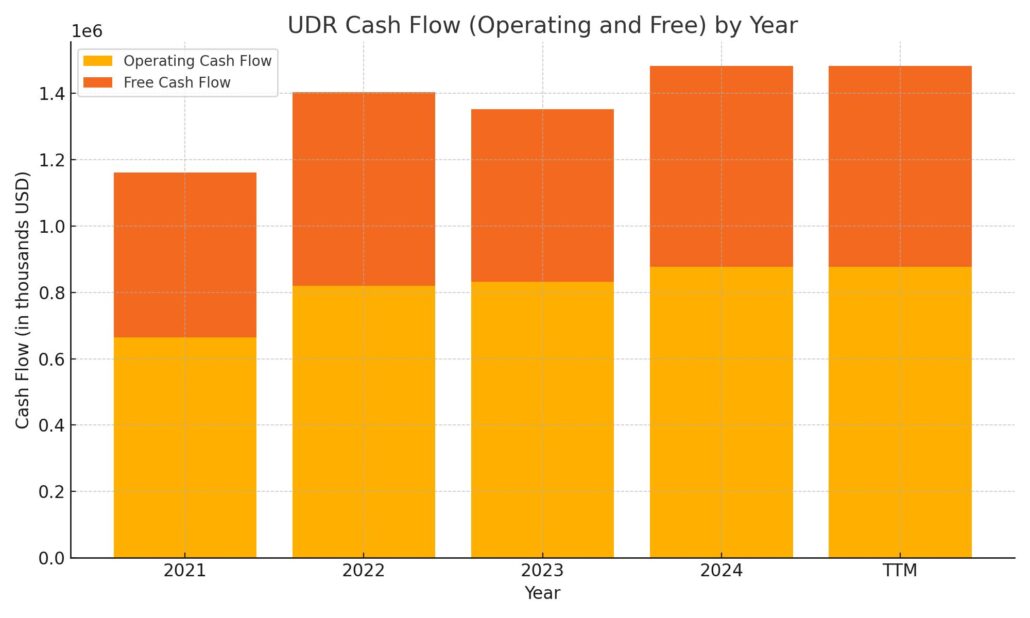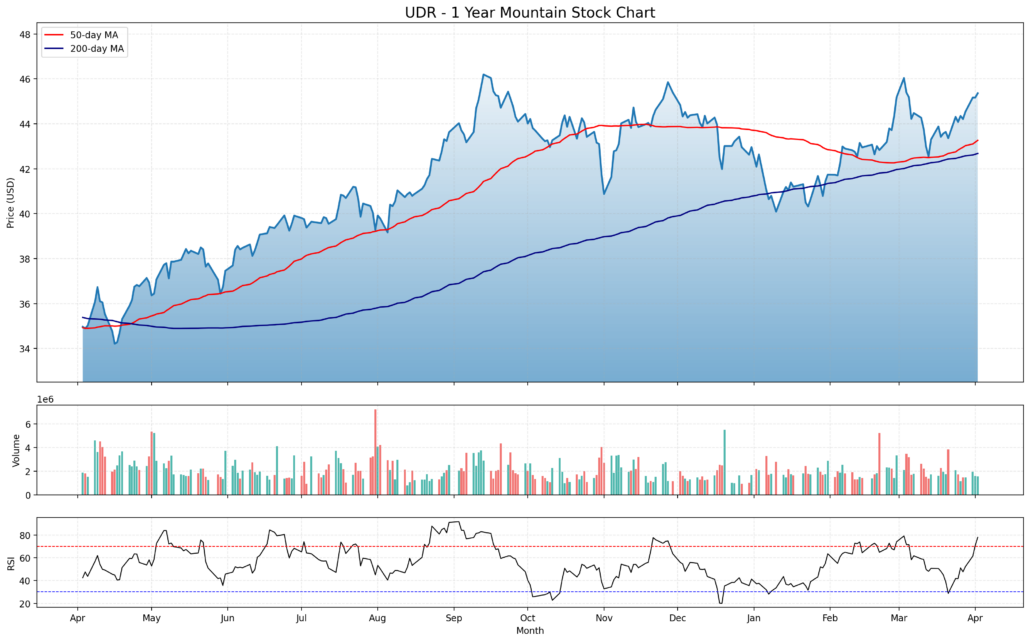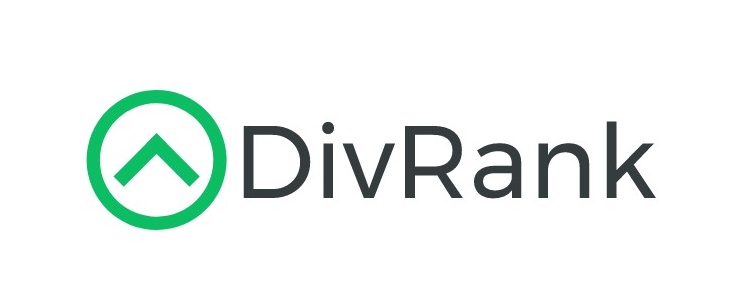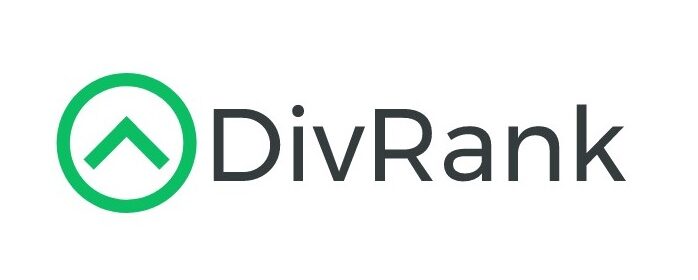Updated April 2025
UDR, Inc. isn’t a name that grabs headlines, but it’s been quietly powering income portfolios for years. This real estate investment trust (REIT) owns and operates upscale apartment communities in some of the country’s most desirable and supply-constrained markets—think areas like Orange County, Boston, and the Bay Area. These are places where people don’t just want to live—they need to. That dynamic gives UDR a stable tenant base and long-term pricing power.
With a market cap just under $15 billion, UDR has carved out a solid position among apartment-focused REITs. It’s a slow-and-steady type of business, the kind many dividend investors look for when they want dependable cash flow, especially during uncertain times.
What sets UDR apart is how it handles its balance between growth and income. Management hasn’t chased headlines or taken wild swings. Instead, they’ve kept a disciplined focus on generating reliable rental income while incrementally raising the dividend along the way.
Recent Events
Lately, UDR’s stock has been on a bit of a rollercoaster. It closed the day at $45.36, only to dip down to $43.50 in after-hours trading—a slide of just over 4%. These swings are common in the REIT space, especially when interest rate chatter starts heating up or inflation expectations begin to shift. REITs are sensitive to those macro trends, and UDR is no exception.
But beyond the daily price moves, UDR’s fundamentals continue to point to strength. The company’s enterprise value has steadily grown to around $21 billion, reflecting confidence from investors and continued growth in property values across its portfolio.
Now, the earnings metrics might raise an eyebrow. A trailing P/E ratio over 170 and a forward P/E of nearly 76 are high by traditional standards. But remember—REITs aren’t judged the same way as tech stocks or industrials. With real estate, it’s really all about the cash, and UDR is throwing off a lot of it. The company reported nearly $877 million in operating cash flow over the last year and a healthy $741 million in levered free cash flow. For dividend-focused investors, those are the numbers that matter.
Key Dividend Metrics
📈 Forward Yield: 3.81%
💸 Payout Ratio: 651.92%
🔁 5-Year Average Yield: 3.65%
📆 Next Ex-Dividend Date: April 10, 2025
📅 Next Payment Date: April 30, 2025
💵 Annual Dividend: $1.72 per share
Dividend Overview
UDR’s dividend yield currently sits at 3.81%, which lands it right in the comfort zone for REIT investors. It’s not chasing sky-high returns, but it’s also not scraping the bottom of the barrel. The company has shown a commitment to maintaining—and slowly growing—its dividend over time. Investors looking for steady cash income from a well-run real estate portfolio will likely find this level of yield attractive.
Now, that sky-high payout ratio? On paper, it looks like a red flag—over 650%. But in the world of REITs, those numbers can be misleading. That ratio is based on net income, which includes heavy depreciation and other non-cash items. It doesn’t reflect the company’s actual ability to generate and distribute cash. That’s why most experienced REIT investors prefer to look at adjusted funds from operations (AFFO) or free cash flow instead, where UDR’s numbers paint a much stronger picture.
Also worth noting is the stock’s beta of 0.87, signaling it moves less than the overall market. That’s helpful for investors looking to add a more stable, income-generating piece to their portfolio.
Dividend Growth and Safety
UDR’s dividend growth is best described as measured. It’s not trying to be the next dividend aristocrat, but it has nudged the payout higher over time, including a modest increase this year from $1.70 to $1.72 per share. That kind of quiet, steady growth tends to be more sustainable over the long haul—especially in a sector like real estate where cash flow consistency is everything.
What keeps UDR’s dividend relatively safe is the quality of its cash flow. With EBITDA coming in at about $1 billion, and a capital structure supported by $6 billion in debt, the company is in a solid spot. Yes, that’s a high debt load, and the debt-to-equity ratio is up over 130%, but that’s fairly common for a REIT with large property holdings. The key is that the properties are income-producing and located in markets where demand isn’t likely to dry up anytime soon.
Liquidity is tight—UDR only holds around $4.5 million in cash—but again, that’s typical. REITs don’t stockpile cash. They tend to reinvest in their properties or distribute it to shareholders, and UDR has done both consistently.
Long-term, the trends seem to favor UDR. As home prices keep climbing and affordability becomes more of a challenge, the rental market in cities where UDR operates is poised to stay strong. That supports rent increases, keeps occupancy high, and gives the company room to continue its cautious dividend growth path.
For those who prioritize income reliability and aren’t chasing outsized yields, UDR has the profile of a long-term income generator. It won’t knock your socks off with explosive growth, but that’s not what it’s here for. It’s built to keep delivering, year after year.
Cash Flow Statement
UDR’s cash flow story over the trailing twelve months reflects the stability and predictability investors often expect from a seasoned REIT. Operating cash flow came in at nearly $877 million, marking consistent growth over the past few years. This strong base of recurring cash flow supports the company’s ongoing dividend payments and signals the health of its core rental income stream. Free cash flow followed suit, reaching $605 million—more than enough to cover the dividend and fund maintenance-level capital expenditures.

On the other side, UDR’s investing cash flow remained negative, typical for a REIT reinvesting in its properties, though at a more moderate pace than in prior years. Financing cash flow also came in negative at nearly $600 million, suggesting the company has been reducing leverage or returning capital. The issuance of $301 million in new debt shows UDR is selectively using the debt markets while keeping an eye on balance sheet discipline. With a modest cash position of $35 million, the company isn’t holding excess liquidity, which aligns with its model of maximizing asset efficiency and relying on operating cash flow to fund obligations.
Analyst Ratings
📊 UDR, Inc. has recently seen a mix of analyst sentiment reflecting its steady position in the REIT sector and modest upside potential. The current consensus among analysts leans toward an “Overweight” rating, with the average price target hovering around $46.38. That puts the target slightly above recent trading levels, suggesting a cautiously optimistic view of the stock’s direction.
📈 Piper Sandler reiterated a “Hold” rating while maintaining a $48.00 price target. Meanwhile, Wells Fargo took a more bullish stance, giving UDR a “Buy” rating and setting the same $48.00 price target. While not an aggressive upgrade, these ratings reflect a recognition of UDR’s financial resilience and operational consistency in a sector that’s been under pressure from rising rates.
🏢 The rationale for these calls centers around UDR’s solid fundamentals. Analysts have taken note of the company’s reliable operating cash flow and its strategic positioning in high-demand metro areas, which help support rental pricing and occupancy. That said, the REIT’s exposure to interest rate sensitivity and elevated leverage have kept some analysts on the sidelines, explaining the split between “Hold” and “Buy” ratings.
🔍 All told, the consensus price target implies a modest upside, with analysts keeping an eye on broader market conditions and UDR’s ability to navigate through them while maintaining dividend stability and asset performance.
Chart Analysis

Price Movement and Trend Behavior
Over the past year, the price action for UDR has shown a steady upward trajectory with moments of volatility, but no major breakdowns. The blue mountain-style shading illustrates a pattern of higher highs and higher lows through much of the year, a classic sign of underlying strength. That said, there were a few noticeable pullbacks around September and again in late January, but none that broke below long-term support levels.
Both the 50-day (red) and 200-day (blue) moving averages provide key context. The 50-day average tracked above the 200-day for most of the year, suggesting a favorable momentum structure. A brief crossover occurred toward the end of the year, signaling a short-lived soft patch, but the 50-day has recently begun turning upward again, which tends to be a healthy sign of price recovery gaining traction.
Volume and Relative Strength
Volume levels have remained relatively stable throughout the chart, with occasional spikes during periods of price consolidation or breakout attempts. None of these moves point to panic selling or overly euphoric buying. The balance of volume reinforces the idea that the price movement is being supported by genuine market participation rather than short-term trading noise.
The Relative Strength Index (RSI) in the bottom pane has stayed mostly within a balanced range, avoiding deep oversold territory and rarely entering extreme overbought levels. It recently climbed toward the 70 level, a potential signal of short-term overextension, but this alone doesn’t indicate reversal—especially if underlying support remains intact. The RSI’s ability to rebound consistently from the 40–50 zone reflects a solid base of buying interest whenever weakness sets in.
Moving Average Alignment and Momentum
The 200-day moving average has been climbing steadily, showing long-term demand for the stock. The 50-day, after a period of flattening and slight decline, has curved back up and is now converging with the 200-day. This closing gap between the moving averages can act as a momentum reset, often preceding a more sustained trend direction if supported by fundamental strength and broader market conditions.
The current price pushing back above both moving averages adds to the positive technical backdrop. If the price holds this level or continues rising with measured volume and moderate RSI, the setup may continue to favor sustained price support over time.
Earnings Report Summary
Steady Core Performance
UDR’s latest earnings release painted a picture of a company holding steady in a changing environment. For the fourth quarter of 2024, the company reported Funds from Operations as Adjusted (FFOA) at $0.63 per share. That’s right in line with what they had guided for, and it matched the same quarter from the year before. So while it wasn’t a blowout quarter, it also didn’t miss expectations—which can be just as important.
On the flip side, net income per share dropped from a gain of $0.10 last year to a small loss of $0.02 this time around. The reason? A non-cash loan reserve related to an investment in one of their assets, 1300 Fairmount. It’s a one-time hit, but it was large enough to pull earnings into the red.
Revenue Growth Meets Higher Costs
One of the more encouraging signs in the report was the 2.1% year-over-year growth in same-store net operating income. That came from a 2.5% bump in revenue, though higher expenses—up 3.4%—took a little shine off that progress. Still, in an environment where costs are rising for just about everyone, holding NOI growth in positive territory is no small feat.
For the full year, UDR posted $2.48 per share in FFOA, a slight increase from the year before. Net income, however, dropped sharply to $0.26 per share, again tied to that Fairmount write-down. It doesn’t reflect the health of their rental business, but it’s a reminder that not every investment pans out as planned.
Strategic Moves and Looking Ahead
UDR also made some portfolio adjustments recently, selling two properties—Leonard Pointe and One William—for a combined total of over $210 million. Moves like these are part of a broader effort to keep the portfolio lean and focused, and to recycle capital into better opportunities.
Looking ahead to 2025, UDR expects FFOA to land somewhere between $2.45 and $2.55 per share. It’s a modest range, but one that reflects a steady hand. The company is also guiding for same-store NOI growth between 0.5% and 3.0%, a sign that management sees continued demand, even if the pace is a bit slower.
On the dividend front, UDR announced a small 1.2% increase, bumping the annual payout to $1.72 per share. It’s not a huge raise, but it signals confidence in the cash flow—and consistency continues to be a core theme for UDR.
Management Team
UDR, Inc. is led by a leadership team with deep experience in the real estate sector. At the top is Chairman and CEO Thomas W. Toomey, who has been guiding the company since 2001. He brought experience from previous executive roles and has overseen UDR through multiple market cycles, keeping a steady hand on growth and operations.
Joseph D. Fisher, who has been with UDR in various financial leadership roles, was promoted to President while continuing his duties as CFO. His long history with the company and knowledge of its financial structure give him a strong grasp on both day-to-day and strategic oversight.
There have also been some recent leadership shifts. Mike Lacy, who joined UDR in 2006 and most recently served as SVP of Operations, was promoted to Chief Operating Officer. He brings operational depth and internal continuity to the role. Tracy L. Hofmeister stepped into the position of Senior Vice President and Chief Accounting Officer, following years of managing technical accounting and reporting. Together, this team blends continuity, operational knowledge, and financial discipline—qualities that support the company’s long-term stability.
Valuation and Stock Performance
As of early April 2025, UDR’s stock trades around $45.36. Over the past year, it’s fluctuated within a range of $35.14 to $47.55. That kind of movement is common in the REIT space, especially when the broader market is digesting inflation data and rate expectations.
The company’s valuation metrics suggest a bit of a premium. A trailing price-to-earnings ratio over 170 and forward P/E near 76 put it on the expensive side compared to peers. But valuation in the REIT space doesn’t always tell the full story—steady cash flow, high-quality assets, and predictable income tend to drive investor interest more than headline earnings.
UDR also trades at a price-to-book ratio of 4.4 and a price-to-sales ratio of nearly 9. Those are elevated, which could either reflect market optimism or simply confidence in the quality and location of its property base. Its beta sits below 1, indicating the stock tends to be less volatile than the broader market, which can be appealing to investors focused on stability.
Revenue over the trailing twelve months came in at $1.7 billion, while net income was about $85 million. While that represents an 81% decline in net earnings year-over-year, most of the hit came from a non-cash reserve linked to a specific investment, not a drop in rental performance.
Despite some recent pressure, the stock has shown resilience. It’s not soaring, but it’s holding its ground while continuing to deliver income and maintain its payout. In a market that rewards consistency, that can count for a lot.
Risks and Considerations
There are a few important factors to consider when looking at UDR. The most obvious one is its sensitivity to interest rates. As borrowing becomes more expensive, it can put a squeeze on profitability and slow new development or acquisitions. And in times when bond yields are more attractive, income-focused investors might rotate out of REITs altogether.
Valuation is another point to watch. With P/E and P/B ratios running well above average, any stumbles in earnings or cash flow could prompt a sharper correction than usual. While quality real estate and a solid tenant base help mitigate some of that risk, premium-priced stocks are always more exposed when the tide shifts.
The health of the real estate market itself also plays a key role. UDR’s properties are in supply-constrained, high-demand urban areas, which is a strategic strength. But if demand weakens due to economic headwinds, occupancy rates and rental pricing could come under pressure. Rising expenses also continue to be a concern, particularly in maintenance, utilities, and labor.
Operational execution is another key variable. UDR needs to stay ahead on technology, efficiency, and tenant satisfaction to remain competitive in crowded metro markets. Leadership transitions, while internally promoted, still carry execution risk if strategic changes don’t pan out as planned.
Lastly, there’s the policy environment. Any shifts in housing regulation, rent control policies, or taxation related to REITs could affect long-term profitability. While those risks are difficult to predict, they’re worth factoring into the bigger picture.
Final Thoughts
UDR stands on a foundation of high-quality assets, experienced leadership, and a consistent income profile. While its valuation may give some investors pause, the company has shown an ability to manage costs, deliver reliable cash flow, and adapt to changing market conditions.
There are headwinds, especially in terms of interest rates, expense pressures, and valuation. But the overall structure of the business—focused on multifamily housing in strong urban markets—continues to support a long-term view grounded in stability and measured growth.
As UDR moves through 2025 with new leadership transitions in place and a steady hand on operations, the stock offers a picture of consistency. That may not always be flashy, but for those seeking reliability in a real estate portfolio, it continues to be worth watching.

